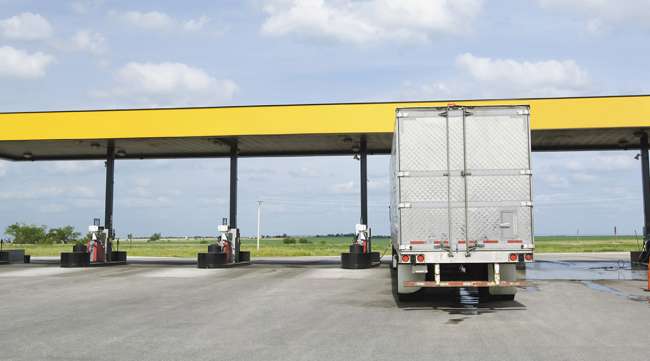Staff Reporter
Diesel Price Slides 0.7¢ to $2.976 a Gallon as It Falls for Eighth Straight Week

[Stay on top of transportation news: Get TTNews in your inbox.]
The U.S. average retail price of diesel dropped 0.7 cent to $2.976 per gallon, the Department of Energy reported Sept. 3, as the price of crude dropped 2% amid the ongoing U.S.-China trade dispute.
The price of diesel has fallen for eight consecutive weeks since July 15, when trucking’s main fuel cost $3.051 per gallon.
Diesel costs 27.6 cents less than it did a year ago, when it was $3.252, DOE said.
Meanwhile the average price of a gallon of gasoline also fell, by 1.1 cents to $2.563 a gallon. The average price of a gallon of gasoline is now 26.1 cents cheaper than a year ago.
All regions saw their respective average diesel price fall, except the Lower Atlantic states, where the average price was unchanged at $2.874 per gallon.
Diesel remains most expensive in California, where it costs $3.885 per gallon. It remains the cheapest in the Gulf Coast region, where it costs $2.74 per gallon, according to DOE data.
While diesel prices dropped, bullish oil traders got a bit of good news Sept. 4, when crude rallied to higher prices. Traders were heartened by news in Hong Kong, where leader Carrie Lam withdrew an extradition bill that Hong Kong citizens feared would surrender some people of the semi-autonomous region to Chinese authorities.
China has been at the heart of global economic fears, as the U.S.-China trade war drags on and protests rock Hong Kong. China and the U.S. said Sept. 5 trade talks would resume in the coming weeks without specifying a date.
Oil traders feared China’s economy was already on a downward trend, but recent data showed a Chinese government stimulus may be working, says a Chicago-based analyst.

Flynn
“China is stronger than we thought,” said Phil Flynn, an oil analyst with the Price Futures Group of Chicago.
Flynn said the Hong Kong decision clears up some uncertainty about China, a major driver of the global economy. The tariff spat between the United States and China remains for now, but Flynn said China imported 10.64 million barrels of oil per day in April, a new record.
Additionally, the Organization of Petroleum Exporting Countries signaled production cuts, while U.S. oil production has leveled off, said Flynn.
On Sept. 4, after the U.S. announced plans to intensify sanctions on Iran, and Russia said it would trim oil production in September, West Texas Intermediate crude for October delivery settled up $2.32 to $56.26 a barrel on the New York Mercantile Exchange, after rising as much as 4.9% earlier in the day, according to Bloomberg News. The Brent November contract added $2.44 to $60.70 a barrel on the ICE Futures Europe Exchange.
Flynn said despite the relatively small ups-and-downs of oil trading over the summer, he is bullish on oil rising in price, despite conflicting reports on the U.S. economy. Flynn said he doubts a recession will come by the end of 2020.
“Are we seeing choppy data? Sure,” Flynn told Transport Topics. “But the demand for oil has been stronger than expected. … The U.S. consumer is still very strong.”
Trucking firms insulate themselves from unsteady diesel prices by improving fuel economy. Many firms turn to software to aid drivers and managers. One such software firm is Vnomics Corp. of Pittsford, N.Y.
Bob Magnant, Vnomics vice president of product development, told TT that the company installs a device in the cab and charges $29 per month for the digital fuel-economy coach.

Magnant
“We provide feedback to the driver in real time,” Magnant said.
The Vnomics systems makes tonal sounds when a driver is not using fuel-efficient driving, akin to the alert drivers get when they hit a rumble strip on a road, but not as jolting, Magnant said. At the end of a journey, the digital Vnomics assistant gives spoken advice on what to do next time and what not to do. Vnomics watches for problems such as speeding, over-idling and over-acceleration.
A key problem the software solves is taking into account the uneven conditions drivers often face, Magnant said. Some drivers haul heavier loads, and some are driving over uneven terrain. Some drivers are in older, less economical trucks. Vnomics takes those factors into account, Magnant said.
“Each truck is its own entity,” said Magnant.
Magnant said the savings per month, per Class 8 truck, could be between $80 and $150.
Vnomics was founded 10 years ago and now has 40 employees, Magnant said.




